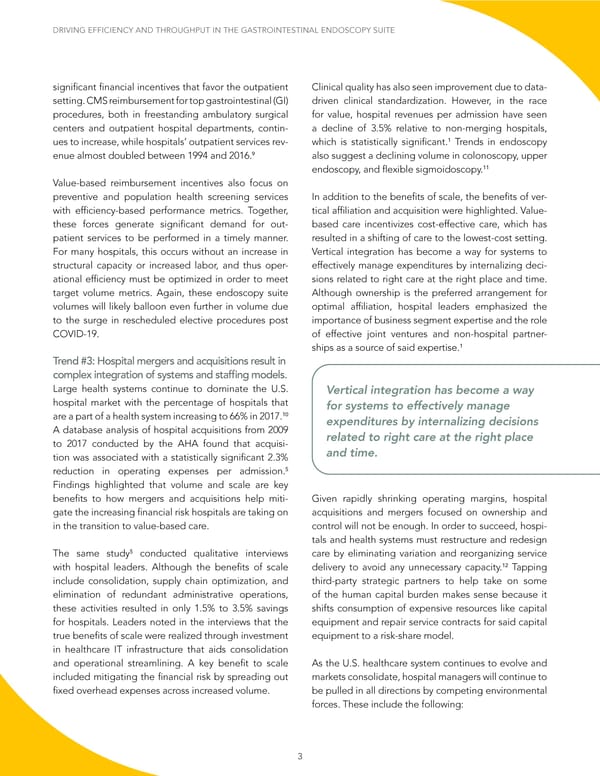DRIVING EFFICIENCY AND THROUGHPUT IN THE GASTROINTESTINAL ENDOSCOPY SUITE significant financial incentives that favor the outpatient Clinical quality has also seen improvement due to data- setting. CMS reimbursement for top gastrointestinal (GI) driven clinical standardization. However, in the race procedures, both in freestanding ambulatory surgical for value, hospital revenues per admission have seen centers and outpatient hospital departments, contin- a decline of 3.5% relative to non-merging hospitals, 1 ues to increase, while hospitals’ outpatient services rev- which is statistically significant. Trends in endoscopy enue almost doubled between 1994 and 2016.9 also suggest a declining volume in colonoscopy, upper 11 endoscopy, and flexible sigmoidoscopy. Value-based reimbursement incentives also focus on preventive and population health screening services In addition to the benefits of scale, the benefits of ver- with efficiency-based performance metrics. Together, tical affiliation and acquisition were highlighted. Value- these forces generate significant demand for out- based care incentivizes cost-effective care, which has patient services to be performed in a timely manner. resulted in a shifting of care to the lowest-cost setting. For many hospitals, this occurs without an increase in Vertical integration has become a way for systems to structural capacity or increased labor, and thus oper- effectively manage expenditures by internalizing deci- ational efficiency must be optimized in order to meet sions related to right care at the right place and time. target volume metrics. Again, these endoscopy suite Although ownership is the preferred arrangement for volumes will likely balloon even further in volume due optimal affiliation, hospital leaders emphasized the to the surge in rescheduled elective procedures post importance of business segment expertise and the role COVID-19. of effective joint ventures and non-hospital partner- 1 ships as a source of said expertise. Trend #3: Hospital mergers and acquisitions result in complex integration of systems and staffing models. Large health systems continue to dominate the U.S. Vertical integration has become a way hospital market with the percentage of hospitals that for systems to effectively manage are a part of a health system increasing to 66% in 2017.10 expenditures by internalizing decisions A database analysis of hospital acquisitions from 2009 related to right care at the right place to 2017 conducted by the AHA found that acquisi- and time. tion was associated with a statistically significant 2.3% 5 reduction in operating expenses per admission. Findings highlighted that volume and scale are key benefits to how mergers and acquisitions help miti- Given rapidly shrinking operating margins, hospital gate the increasing financial risk hospitals are taking on acquisitions and mergers focused on ownership and in the transition to value-based care. control will not be enough. In order to succeed, hospi- tals and health systems must restructure and redesign 5 The same study conducted qualitative interviews care by eliminating variation and reorganizing service 12 with hospital leaders. Although the benefits of scale delivery to avoid any unnecessary capacity. Tapping include consolidation, supply chain optimization, and third-party strategic partners to help take on some elimination of redundant administrative operations, of the human capital burden makes sense because it these activities resulted in only 1.5% to 3.5% savings shifts consumption of expensive resources like capital for hospitals. Leaders noted in the interviews that the equipment and repair service contracts for said capital true benefits of scale were realized through investment equipment to a risk-share model. in healthcare IT infrastructure that aids consolidation and operational streamlining. A key benefit to scale As the U.S. healthcare system continues to evolve and included mitigating the financial risk by spreading out markets consolidate, hospital managers will continue to fixed overhead expenses across increased volume. be pulled in all directions by competing environmental forces. These include the following: 3
 Driving Efficiency & Throughput Page 3 Page 5
Driving Efficiency & Throughput Page 3 Page 5